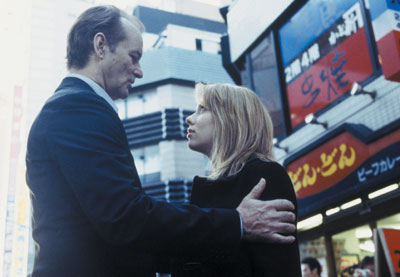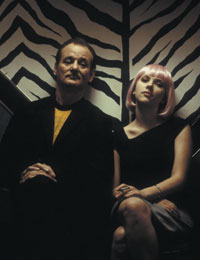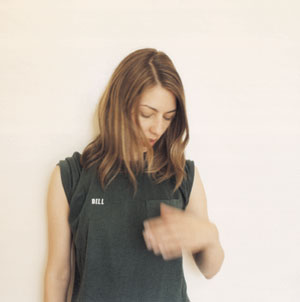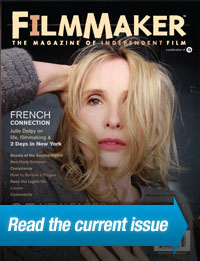TOKYO STORY
Anne Thompson muses on the loneliness of the long-distance filmmaker with Lost in Translation's Sofia Coppola, Scarlett Johansson and Ross Katz.
Lost in Translation writer-director Sophia Coppola.
Photo: Melodie McDaniel.
Sofia Coppola knows from jet lag. And she knows Tokyo, quite well — she used to fly there once a year for Milkfed, her clothing design company.
“Jet lag makes you contemplate life in a different way,” she says. “You’re far removed from all the distractions of your normal life.” Perched on a sofa in the lobby of the Chateau Marmont Hotel, she’s in navy blue (T-shirt, jeans, flip-flops) except for her toenails, which are baby pink.
Between working her clothing line, shooting her music videos and promoting her first film, The Virgin Suicides, Coppola has spent a fair amount of time in hotels. So during the past two years of travel, she found herself concocting a romantic story about a pair of culturally alienated Americans knocking about in a hotel in Tokyo. “I thought it would be funny to see Bill Murray in that context,” she recalls.
When she arrived back home in Los Feliz from promoting The Virgin Suicides, Coppola spent six months writing Lost in Translation. “It’s about misunderstandings between people and places,” she says. “It’s about things being disconnected and looking for moments of connection. There are so many moments in life when people don’t say what they mean, when they are just missing each other, waiting to run into each other in a hallway.”
She labored through the first 20 pages with support from her brother Roman, also a director (CQ), and then returned to Tokyo for further inspiration. “It helped to remember what I had liked,” she says. “I always loved the Park Hyatt. I wanted to shoot a movie in that hotel. I like the way you keep running into the same people over and over again, the camaraderie of foreigners.”
In Lost in Translation, 20ish Charlotte, whose photographer husband is on a job, keeps running into Bob, a 50ish movie star who is in town to shoot a whiskey commercial. They are both lost and vulnerable, and despite their age gap, they bond in a romantic — though not sexual — way. Coppola says she was inspired by the dynamic between Humphrey Bogart and Lauren Bacall in Howard Hawks’s classic noir, The Big Sleep. “I wanted the movie’s structure to have all the different parts of a relationship condensed in a few days,” she explains. “They meet, they break up.”
 |
| Bill Murray and Scarlett Johansson
in Lost in Translation. |
Precisely observed and with a luxuriously languid pace, Lost in Translation captures the loneliness of a young wife seeking her identity, the loneliness of a married man in midlife crisis and the way two strangers can come together to supply something that is missing in each of them. As a director, Coppola takes the time to observe tiny real-life details; remarkably, in this music-video age, she lets the movie breathe.
Once Coppola finished her script, she and her ICM agent, Bart Walker, decided to seek financing for the film “Jim Jarmusch– style.” In this model, the filmmaker licenses distribution rights in various overseas territories individually, cobbling together enough foreign presales to make the film without the controlling influence of a single territory or U.S. domestic distributor. “I didn’t want to make something I’d have to change,” Coppola remarks. “I had an idea of what I wanted to make, and I wanted to not have a boss. It’s hard to get final cut, but it was very important to me to have the freedom to do [the film] the way I wanted.”
The problem with the Jarmusch method, though, is that few American filmmakers possess the international appeal to completely finance their films from foreign distributors. And typically these distributors are more comfortable financing an American indie knowing that a U.S. distributor is also on board to launch the film in North America. And then there was one other problem: Coppola’s script was only 70 pages long, causing some potential financiers to worry that the finished film would not be feature-length.
So, rather than shop a sparse script to the usual suspects in the U.S., the filmmakers went first to Japan, where The Virgin Suicides was a crossover hit. The film’s success there enabled the filmmakers to start in what would be their production home base on terms more advantageous than those customarily granted a U.S. indie. Theatrical distributor Tohokushinsa prebought the territory and then, with producer Ross Katz reassuring everyone that the film would time out at 90 minutes (“Something that is half a page in the script — Charlotte walks alone in Kyoto — is a four-minute sequence,” Katz would explain), the French distributor Pathe boarded the project. At this point, the team entered discussions with Focus International hoping the foreign sales company would commit to selling the rest of the world and close the gap on the $4- million budget. To convince Focus of the film’s appeal, the filmmakers closed one additional territory by selling Italian rights themselves to Mikado. Focus then committed to the remainder of the financing, and when Coppola finished her first cut, the domestic releasing arm, Focus Features, bought the U.S. rights as well.
From the start, Coppola had her heart set on Bill Murray for her lead. “Sofia wrote the movie for Bill,” Katz says. “She wasn’t going to make it if he didn’t do it.” But there were two problems. First, the film couldn’t afford to pay Murray anywhere near his Hollywood quote. And second, Murray is notorious for being hard to reach and pin down. “It’s almost like a challenge to get through all the obstacles when someone tells me I can’t do something,” Coppola says. “It makes me try even harder. For five months it was like a full-time job, contacting Bill Murray.”
A mutual friend, screenwriter Mitch Glazer, encouraged Coppola and showed Murray her treatment early on. “And he helped me with my stalking,” she says. “Bill had all these big movies that were offered to him. It was this long-shot thing: Was he going to do this little movie for no money? It would have been definitely heart-rending if he didn’t want to do it.”
| SOFIA COPPOLA'S TOP TEN FILMS |
| All That Jazz • Badlands • Darling • GoodFellas • The Heartbreak Kid
Lolita • The Piano • Rumble Fish • Safe • Tootsie Click on a title to purchase it from Amazon.com. |
Murray finally indicated that he was interested in playing the lead. Coppola got a cell phone call one night asking her to join Murray at a downtown New York restaurant where he was dining with friends. In her sole meeting with the actor, she spent five hours with Murray, connecting with him but barely discussing the film. But even though Murray said he was prepared to play the lead, the production was unable to obtain a signed contract from him before production. For an international production stitching together three foreign distributors, one U.S. sales company, a completion bond company and the French bank Natexis, not having your lead actor “signed” was yet another obstacle. But director Wes Anderson, who worked with Murray in Rushmore, told Coppola, “If he says he’s going to do it, he’ll show up.”
So, with cash flow from trusting Tohokushinsa, Coppola and Katz spent $1 million in preproduction costs without knowing for sure that Murray was going to arrive on set. “It was nerve-wracking,” Coppola says. Finally, one week before filming, she received a call from Katz, who had just greeted Murray at the airport: “The Eagle has landed!”
Any worries about Murray evaporated once shooting started. “Bill was such a good sport about it,” she recounts. “He was sweet. He said, ‘I thought if you were going to put yourself on the line, I would too.’ ” In the film he gives a devastating performance, both hilarious and tragic, that could wind up earning him an Oscar nomination.
To play her younger alter ego, Charlotte, the lonely tourist left alone by her photographer husband (Giovanni Ribisi), Coppola cast Ghost World’s Scarlett Johansson, who turned 18 during the shoot and bears a striking resemblance to her director. Coppola admits that she’s embarrassed by how much she and Johansson look alike. “It’s narcissistic. I relate to her. I liked her demeanor; she’s understated, not extroverted and hyper. There’s a part of me in that character. She’s in her early 20s, having a breakdown, like the girl Franny in Franny and Zooey. It’s a culmination of different stages of my life in that character.”
“You can see the film is very personal,” Johansson adds. “Sofia bleeds through the character — her ironic sense of humor, that feeling of being lost and disillusioned and trying to figure out what direction you want to take with your life.”
For the shoot, Coppola arrived in Tokyo loaded down with maps, blueprints, sketches, snapshots (she is an accomplished photographer) and an iPod, ready to communicate what she was looking for. “She knew the movie upside down and backward,” Katz comments. “She spilled it right from her head onto the screen.”
 |
| Bill Murray and Scarlett Johansson in Lost in Translation. |
Those references included music like the dreamy noise-pop of the Irish band My Bloody Valentine (whose reclusive leader, Kevin Shields, wound up contributing four songs to the film’s soundtrack) as well as some of Coppola’s favorite films. Wong Kar-wai’s In the Mood for Love “has the feeling of being on the verge of something happening,” Coppola says. She admires the way director Bob Fosse reveals his personal life in All That Jazz. “I enjoy movies when they’re sincere, from personal experience. Fosse got away with his girlfriend playing his girlfriend. It’s not an all-romanticized idea of himself. It’s honest.” And though Antonioni’s L’Avventura “has no plot, it isn’t boring. I like taking your time meandering with the music. There’s so much that isn’t said in a look. I like observing things. I’m not interested in a lot of dialogue.”
Because the script was so spare, there was room for spontaneous maneuvering. “A lot of dialogue was added at the spur of the moment,” Johansson remembers. “She allowed us to improvise, and she’d pull some ideas, lines, deliveries, movements; silly things like, I’d come in my slippers and she’d say, ‘Oh, you should put those on.’ She was perceptive while we were rehearsing.”
Much of the movie was shot Dogme- style. Ironically, Coppola discovered that it was easier to “run and gun” in a foreign country, where the laissez-faire attitude of the Japanese toward location shooting made things easy. In fact, it was the Americans who asked the Japanese to supply paperwork for every extra and location. With a handheld Aaton camera, the filmmakers made impromptu forays onto subway trains and teeming Tokyo streets, where the Japanese reluctance to make eye contact was a plus. And during the shoot, Coppola’s brother Roman grabbed second-unit shots of blurry neon around the city.
Although there was initial pressure to shoot on less expensive video, Coppola opted, somewhat sentimentally, to shoot on film instead. Her videophile father, Francis Ford Coppola, had told her, “You might as well shoot film. It’s not going to be around very much longer,” and Coppola herself thought film would help to evoke a “fragmented, dislocated, melancholic, romantic feeling. [Lost in Translation] is the memory of an enchanted few days. Video feels more immediate, in the present.”
| HOW THEY DID IT |
| Production Format
Shot on 35mm. |
| Camera Manufacturer and Model
Aaton 35. |
| Film Stock
Kodak 5263. |
| Editing System
Avid. |
| Color Correction Process
Conventional film answer printing. |
On another day, Coppola reversed the usual movie protocol of heading to an indoor “cover set” in bad weather. As a hazy rain made the city foggy and atmospheric, Coppola scrapped the interior she was shooting to grab a sequence with Charlotte walking outdoors. “In the course of 15 minutes we broke our plan and shot exteriors in the rain,” Katz says. “We shot Scarlett walking through the Shibuya with hundreds of translucent umbrellas, steam coming off the rooftops and the noodle shops. Afterward we had to deal with losing a location, but it was worth it.”
For the production, Katz blended American key crew members — a U.S. line producer, production designer, costume designer, d.p., sound recordist and a New York–based Japanese a.d. — with Japanese seconds and thirds. The a.d. translated for the Japanese crew, but some cultural differences weren’t so easily glossed over. “Respect and honor are central to Japanese culture,” Coppola notes. “We wanted to do [the movie] more Japanese-style, not walk in and say, ‘Well this is how we do it in America.’
“However, when we were at the shabu-shabu restaurant, we were only permitted to shoot till 4 p.m.,” she continues. “We went about 10 or 15 minutes over, and the owner pulled the plug — pulled the lights out. We were disrespecting the owner because we weren’t done.” Coppola finished the take in the dark (and printed it too). But as they wrapped, the film’s location manager resigned. “We had caused him to lose face with the owner,” Katz says.
In the end, Coppola had both the confidence and flexibility to immerse herself deep in a foreign culture and figure out how to blend the best of the American and Japanese styles of filmmaking. And her Tokyo filmmaking adventure made the 32-year-old director even surer about what she’s doing with her life. “I can’t imagine,” she says, “doing anything else that could be as much fun.”
VOD CALENDAR


 See the VOD Calendar →
See the VOD Calendar →



